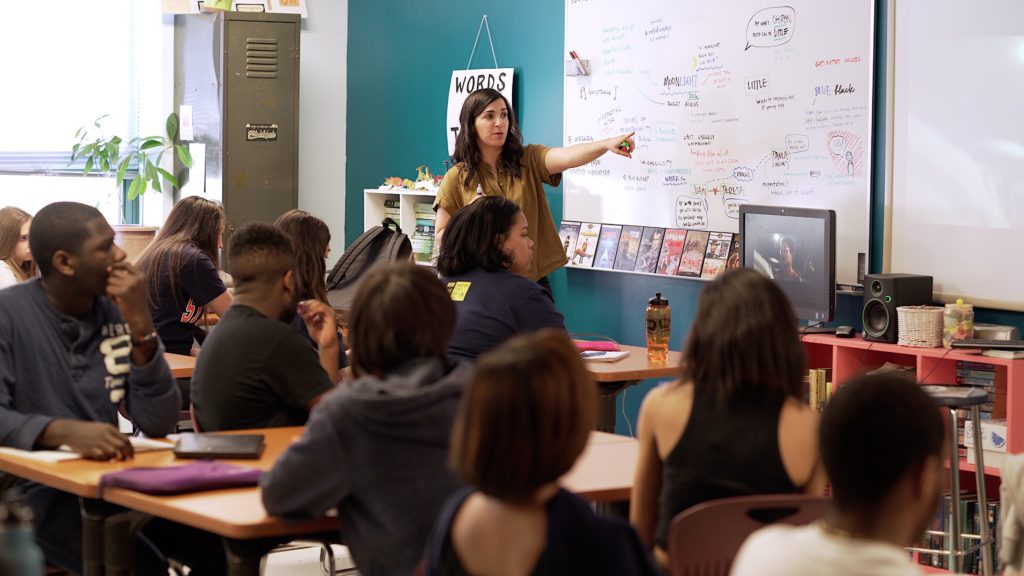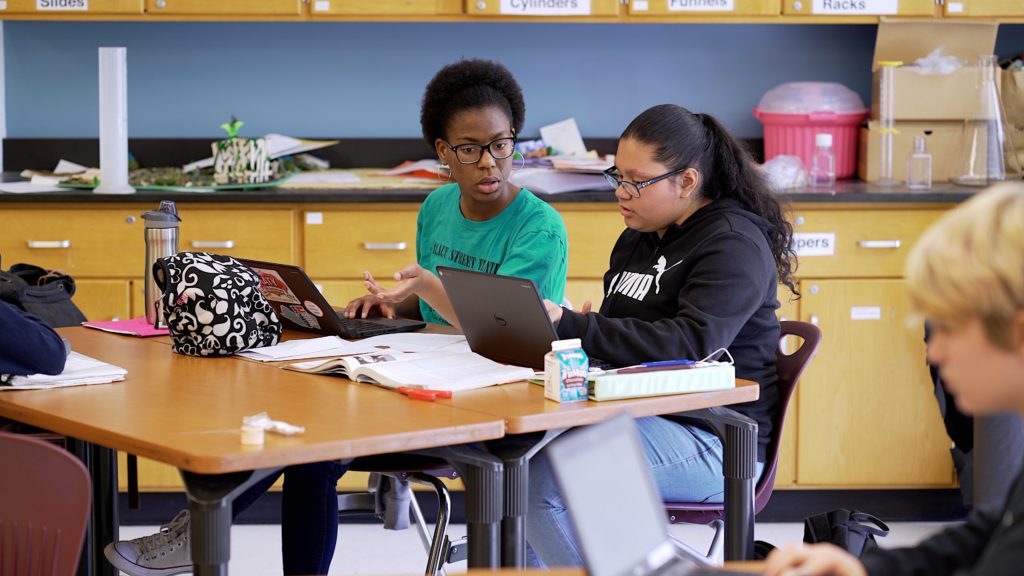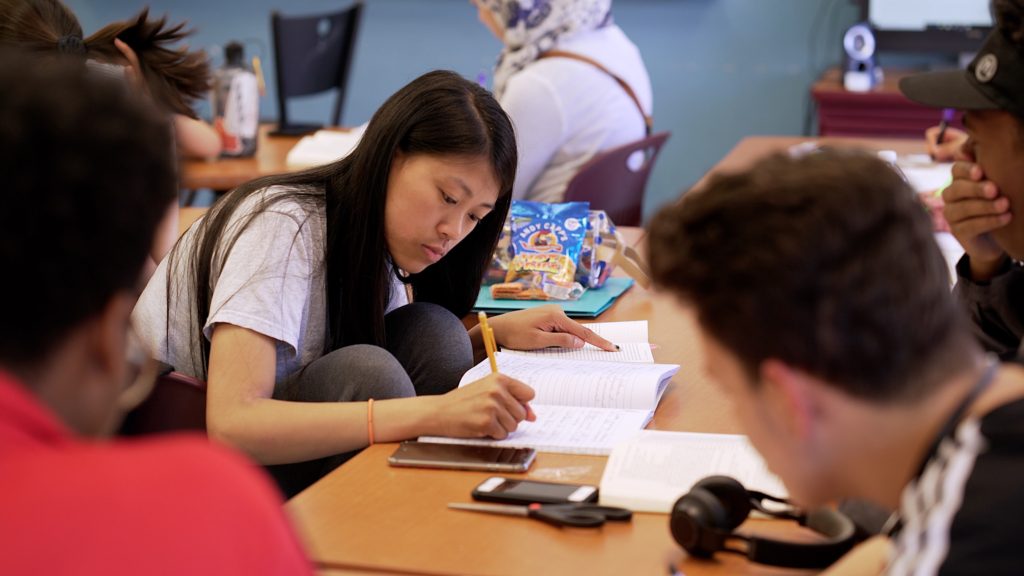Part of the school day for the students at the Science Leadership Academy (SLA), in Center City Philadelphia, might look similar to the one you had. For example, everyone hustles out of class moving onto the next period throughout the day. But, what goes on in each class at SLA is a bit different from the model you might have experienced during your time in high school.
From the schedule students follow to the way students learn, things at SLA are most likely not what you experienced. Founded as a partnership between the School District of Philadelphia and the Franklin Institute, SLA is on its own educational journey.

SLA, which opened its doors in 2006, is part of the School District of Philadelphia’s Innovation Network. Meaning it is a public Philadelphia high school, but because of its status within this network, established in 2015, it’s allowed to operate outside of the traditional high school constructs you’ve come to expect.
Inside the classrooms of SLA, students are learning through an inquiry-driven, project-based curriculum. They engage in rigorous and modern learning experiences, which emphasize the process as much as the outcomes. In practice this looks like teachers and students asking questions, and then students finding the answers to these questions through thoughtfully crafted projects.
Instead of seeing days made up of lesson plans, teachers at SLA want students to learn how to think and analyze problems. Thus teachers develop real schema around subjects as opposed to units or chapters. Students share that at SLA they are like “researchers” asking questions and making connections to solve real problems.
The student body represents every single zip code of Philadelphia, a demographic intentionally created by the school’s architects. Beyond their demographic diversity, students feel safe here, safe to dress how they want and safe to express their opinions. Students embracing their own style is not an SLA phenomena, but when you go into a classroom, and hear students sharing their thoughts on a recently completed book, it is evident that students feel a unique ownership of the space.

This feeling of safety is inculcated thanks to a strong culture at SLA where teachers practice what is referred to as “an ethic of care” for each student. This care is institutionalised through advisories, in which groups of twenty students meet with one teacher (their advisor) twice a week for the entirety of their time at SLA. The relationship between student and advisor, and between student and their fellow advisees, flourishes from year to year.
At the start of freshman year, advisories are intentionally created to represent a diverse cross-section of the student body. All students are in the same advisory for their full time at SLA. These advisories are a priority at SLA, and thus rather than scheduling them at the beginning of the day when they are easy to skip, they are held twice a week in the afternoon. This structure ensures that every student has at least one adult in the building who is looking out for them.
Given that all teachers are also advisors, advisories serve to remind teachers not to see kids as just students of a subject in their classes. In the upper grades, advisors lead students through the college application process and leverage their relationships to produce meaningful recommendation letters.
To operationalize personalization at SLA, each student has an individualized learning plan (ILP) which provides increasing choice and autonomy in the upper grades with how students demonstrate their learning. During sophomore and junior year, ILP’s include internships across the city and participation in Career and Technical Education, while seniors work independently on senior capstone projects of their choice. Seniors also have the opportunity to participate in the Student Assistant Teacher (SAT) program, where they act as a teaching assistant for underclass courses.

The unique aspects of SLA discussed above would not be possible without a series of systems and structures, which acts as the glue that binds them together. At SLA, this glue takes forms in the ubiquitous core values and rubrics.
Across every classroom and subject, the same rubric is used to assess student work on the following criteria, which builds off of these values: design, knowledge, application, presentation, and process. Core values are not just posted in every classroom but integrated into conversations and expectations for both students and teachers.
Further, all teachers apply the Understanding By Design (UBD) framework in their classrooms which keeps consistency across classrooms and subjects. Taken together, the core values, the rubric, and UBD ensure consistent expectations across the school.
Over the years, SLA has been able to sustain its approach by building human-centered systems and structures that reflect its core values. These structures demystify the learning process. SLA students note that this method provides a clear understanding of the expectations they must meet for each class.
These institutionalized, intentional, and interconnected systems and structures, provide educators with support and promote needed accountability. SLA’s leadership considers the explicit reason for each school system and structure to ensure that it is in service of the school’s core values. The most notable structure is the schedule. Students spend two days a week in advisory to build school culture and teachers teach one fewer course than in the District to ensure that advisory is not an afterthought. Full-credit courses meet four times a week and bump up one class period every day so students can experience subjects at different times of the day. The schedule also provides teachers with consistent time each week to engage in meaningful collaboration.
The systems and structures implemented at SLA not only make for smooth logistics, but also lead to real academic achievement, especially when compared to the District’s performance as a whole. Currently, the School District of Philadelphia’s 87 high schools have, on average, a 67% four-year graduation rate, with 34% and 44% of students scoring at or above proficient on the state Keystone assessments in math and literature, respectively. In comparison, SLA boasts a 99% graduation rate, with Keystone proficiency rates well above the District average, at 63% and 88%. These achievement rates are also the highest amongst those schools in the innovation networks.
From the schedule to advisories, gradually increasing student independence and so much more, the many puzzle pieces of SLA fit together to create a unique thriving learning community. SLA does not just say it wants students to feel cared for and to help them learn through doing, it institutes the systems to make this a reality.
This article is part of our Philadelphia Innovation High School series, that was created in partnership with the Barra Foundation.

